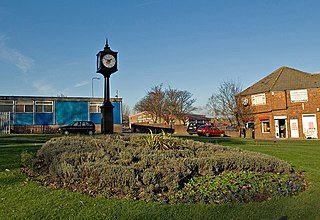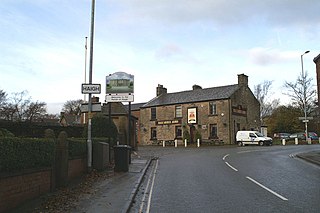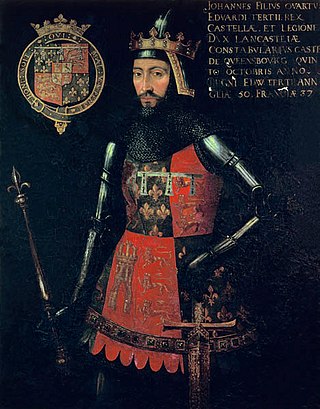
Westhoughton is a town and civil parish in the Metropolitan Borough of Bolton, Greater Manchester, England, 4 miles (6 km) southwest of Bolton, 5 miles (8 km) east of Wigan and 13 miles (21 km) northwest of Manchester.

Aspull is a village in the Metropolitan Borough of Wigan, in Greater Manchester, England. Historically in Lancashire, Aspull, along with Haigh, is surrounded by greenbelt and agricultural land, separated from Westhoughton, on its southeast side, by a brook running through Borsdane Wood. The ground rises from south to north, reaching 400 feet (122 m), and has views towards Winter Hill and the West Pennine Moors. It has a population of 4,977.

Haigh is a village and civil parish in the Metropolitan Borough of Wigan, Greater Manchester, England. Historically part of Lancashire, it is located next to the village of Aspull. The western boundary is the River Douglas, which separates the township from Wigan. To the north, a small brook running into the Douglas divides it from Blackrod. At the 2001 census it had a population of 594.
The Bradshaigh Baronetcy, of Haigh in the County of Lancaster, was a title in the Baronetage of England. It was created on 17 November 1679 for Roger Bradshaigh, formerly a Member of Parliament for Lancashire. The second Baronet represented Wigan and Lancashire in Parliament. The third Baronet sat as Member of Parliament for Wigan for over fifty years and was Father of the House of Commons. The title became extinct on the death of the fourth Baronet in 1770. He was buried at Wigan Parish Church on 3rd. December 1770.

All Saints' Church in Wallgate, Wigan, Greater Manchester, England, is an Anglican parish church. It is in the deanery of Wigan, the archdeaconry of Warrington and the Diocese of Liverpool. The church is recorded in the National Heritage List for England as a designated Grade II* listed building, and stands on a hill in the centre of the town.

Blackrod is a town and civil parish situated within the Metropolitan Borough of Bolton in Greater Manchester, England. Nestled in the historic County of Lancashire, Blackrod is positioned 3.9 miles northeast of Wigan and 6.6 miles west of Bolton. According to the United Kingdom Census of 2021, the town has a population of 5,345.

Edward Haytley was an English portrait and landscape painter of the 18th century. He was born in 1713, but his works are documented to the period 1740–1764; other biographical detail is equally sparse, but the background of some early professional associates and early sitters suggests he may have come from Lancashire.

Ainscough is an Old Norse, Scandinavian surname, also spelled Ayscough, Aiskew, Askew, Ascough and Aynscough.

Wigan is a town in Greater Manchester, England, on the River Douglas. The town is midway between the two cities of Manchester, 16 miles (25.7 km) to the south-east, and Liverpool, 17 miles (27 km) to the south-west. Bolton lies 10 miles (16 km) to the north-east and Warrington 12 miles (19 km) to the south. It is the largest settlement in the Metropolitan Borough of Wigan and is its administrative centre. The town has a population of 107,732 and the wider borough of 330,714. Wigan is part of the historic county of Lancashire.

Wingates is a small settlement located in the town of Westhoughton, in the Metropolitan Borough of Bolton, Greater Manchester, England. The name is believed to mean 'a gate for the wind', and it seems likely as this is in an exposed position above Westhoughton. It has also been known as Win-yate and Windyates. Historically part of Lancashire, it lies mainly along the A6 road between Blackrod and Walkden.

The High Sheriff of Lancashire is an ancient office, now largely ceremonial, granted to Lancashire, a county in North West England. High Shrievalties are the oldest secular titles under the Crown, in England and Wales. The High Sheriff of Lancashire is the representative of the monarch in the county, and is the "Keeper of The King's Peace" in the county, executing judgements of the High Court through an Under Sheriff.

There are 37 scheduled monuments in Greater Manchester, a metropolitan county in North West England. In the United Kingdom, a scheduled monument is a "nationally important" archaeological site or historic building that has been given protection against unauthorised change by being placed on a list by the Secretary of State for Digital Culture, Media and Sport; Historic England recommends sites for scheduling to the Secretary of State. Scheduled monuments are defined in the Ancient Monuments and Archaeological Areas Act 1979 and the National Heritage Act 1983. There are nearly 20,000 entries on the schedule, which is maintained by Historic England as part of the National Heritage List for England; more than one site can be included in a single entry. While a scheduled monument can also be recognised as a listed building, Historic England's aim is to set the most appropriate form of protection in place for the building or site. Applications to deschedule a site are administered Historic England, who will carry out an assessment and make a recommendation to the Secretary of State.

Radcliffe Tower is the only surviving part of a manor house in Radcliffe, Greater Manchester, England. It is a Grade I listed building and a Scheduled Monument. The house was rebuilt in 1403 by James de Radcliffe, who was lord of the manor of Radcliffe, and consisted of a stone-built hall and one or two towers, probably built with ashlar blocks. De Radcliffe was given a royal licence to fortify the site including adding crenellations and battlements.

There are 236 Grade II* listed buildings in Greater Manchester, England. In the United Kingdom, the term listed building refers to a building or other structure officially designated as being of special architectural, historical or cultural significance; Grade II* structures are those considered to be "particularly significant buildings of more than local interest". In England, the authority for listing under the Planning Act 1990 rests with English Heritage, a non-departmental public body sponsored by the Department for Culture, Media and Sport.

Haigh Hall is a historic country house in Haigh, Wigan, Greater Manchester, England. Built between 1827 and 1840 for James Lindsay, 7th Earl of Balcarres, it replaced an ancient manor house and was a Lindsay family home until 1947, when it was sold to Wigan Corporation. The hall is recorded in the National Heritage List for England as a designated Grade II* listed building and is owned by Wigan Council.
The Great Haigh Sough is a tunnel or adit driven under Sir Roger Bradshaigh's estate between 1653 and 1670, to drain his coal and cannel pits in Haigh on the Lancashire Coalfield. The sough's portal and two metres of tunnel from where it discharges water into the Yellow Brook at Bottling Wood is a scheduled monument.
Sir Roger Bradshaigh, 1st Baronet was an English politician who sat in the House of Commons from 1660 to 1679.

The Banastre Rebellion was an uprising in Lancashire, England, in 1315 against the Earl of Lancaster and his supporters. A group of disaffected knights decided to revenge themselves on the Earl of Lancaster by attacking his chief retainer and their rival, Sir Robert de Holland. The group was led by Sir Adam Banastre of Bank Hall, Bretherton, who had extensive landholdings in the county, Sir William de Bradshaigh of Haigh Hall and Sir Henry Lea of Charnock Richard. The cause of their grievance was that the powerful earl, the dominant force in the north-west of England, appeared to be favouring the Holland family to their disadvantage.
Blackrod was, from 1872 to 1974, a local government district centred on the village of Blackrod in the administrative county of Lancashire, England.

Dorothy Bradshaigh, British letter writer and cookery book compiler. After her marriage she lived at Haigh Hall near Wigan. Her letters and suggestions to Samuel Richardson influenced his novel The History of Sir Charles Grandison.

















